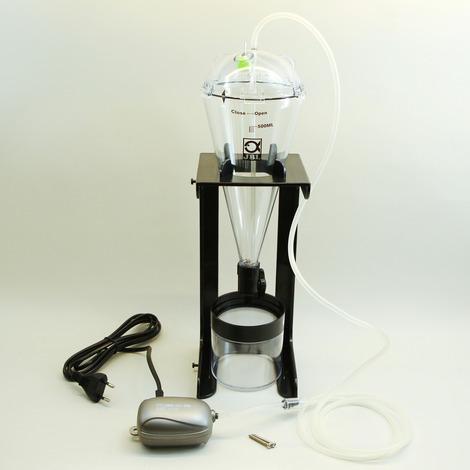
JBL Artemio Set (complete brine shrimp hatchery)
- Artemia nauplii home-grown in 24-48 hours: cultivation equipment with stand and air pump.
- Assemble culture device, connect air pump, add water, salt and Artemia eggs, allow 24-48 h for hatching brine shrimps to run out, and catch them in sieve. Feed crustaceans to the fish.
- Effective: maximal hatching rate as a result of the naupilia’s constant movement and funnel shape, separation of the nauplia from the breeding water with Artemia sieve (0.15 mm mesh size), nauplia removed using harvesting container
- Extendable by combining with other breeding containers, several containers with staggered setting up times: continuous supply for sensitive young fry
- Package contents: 1 breeding kit for live food, ArtemioSet. Incl. 1 funnel shaped breeding container with dome cover, 1 stand with screws, 1 air pump, 1 harvesting container, 1 Artemia sieve, 1.8 m air hose, 1 check valve.
PRODUCT INFORMATION
Fish love a varied diet
- An unbalanced fish diet can lead In the long term to deficiency symptoms, diseases and fatty degeneration of organs. Provide your aquarium dwellers with a varied died in the form of live food. When catching or purchasing live food there is a risk of introducing bacteria and parasites into the aquarium.
Producing your own live food has many advantages:
- Free of parasites
- Rich in fibre & healthy
- Not just a „pool“ anymore
- Promotes the hunting instinct of the fish
- Increases readiness of spawning
- Easy, quick and convenient
- Affordable alternative compared to frozen food
- It’s fun to do it yourself
Easy to use:
- Place breeding container in the stand provided. Fill it with water, add special salt and Artemia eggs (not included) to the container.
- Close the breeding container.
- Connect air pump and let it aerate for 24 – 48 hours.
- Open stopcock at the bottom of breeding container.
- Breeding water flows through the sieve and separates water from the live food.
FAQ
How can I remove the hose from the device?
> At first the air hoses and special CO2 hoses can easily be pushed on the connection piece. The hoses harden more and more as the months go on and can only be removed from the connection piece using great force. If you pull the hose hard it will only strain the connection, which could, in the worst case, even break off. Instead cut the hoses you want to remove laterally at the ends and carefully remove them. For this it’s always advisable to install hoses with some reserve in its hose length.
How can I remove the lids of the JBL Artemio sets and the JBL Artemio 1 easily while reducing wear ?
> To remove the lid of the Artemio reactor more easily and thus protect the sealing we recommend greasing the lid with JBL Silicone Spray. Thus the lid is easier to remove and the sealing is treated with care.
How do I clean the reaction vessel properly?
> It should be washed by hand. The plastic may be damaged in a dishwasher. A washing-up brush, bottle brush or JBL WishWash can be used in addition. JBL PowerClean or BioClean A can be used as a cleaning solution to remove coarse dirt and make cleaning possible.
JBL ArtemioSet, JBL Artemio 3: Why doesn't the water from the breeding reactor flow through the fine sieve?
At the beginning, you may actually find that the water from the breeding reactor is not flowing through the fine sieve. This can happen when
- a fresh, dr
- a used sieve that has not been rinsed properly is used,
- a sieve that is dried out is used.
Possible remedies:
1) Moisten the sieve on both sides beforehand to remove the air from the pores so that the water can flow through freely.
2) Tap on the underside of the sieve. This contact causes the water to be drawn through the sieve and the effect to spread across the surface of the sieve.
This is due to the sieve's fine structure with a mesh size of 150 µm and the so-called cohesion of the water molecules. Water molecules combine to form larger units (clusters), which is why water is liquid between 0 °C and 100 °C. Otherwise, it would be gaseous. When you have a fine, dry sieve, the cohesion prevents the water from passing through initially, because the pores are still filled with air. By contrast, when you have a moist sieve or have established contact on the underside, a suction effect occurs which breaks up the clusters, thereby permitting water to flow through the sieve.
The reactor of the JBL Artemio Set or JBL Artemio 1 is constantly clogged by a drop of salt. Is that normal?
> This only happens when the hose is immersed in the salt mixture that has been added or if the power supply is interrupted for an extended period of time so that the water was able to flow back into the hose.
Tip when using: Before you fasten the lid on the Artemio, turn on the air pump. Then, when the air tube is immersed in the water with the mixture, which may not have dissolved yet, the exiting air will prevent JBL Artemio Mix or JBL Artemio Sal and JBL Artemio Pur from settling in the air tube and forming a salt plug.



